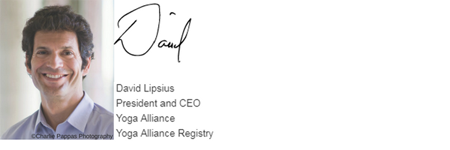
Dear fellow Yoga Alliance members,
Before I offer this update on the evolution of Yoga Alliance, please allow me to thank you for all that you are doing to help society through the teaching of yoga. While yoga teachers may at times be overlooked or undervalued, Yoga Alliance and I want you to know that we see your enormous contribution to the health and well-being of your communities, and the positive social impact that ripples out from your hard work, talent, and ongoing commitment to teaching with integrity.
We’re grateful for the opportunity to support community leaders like you, which is why we’re gathering data that will help to guide us as we move forward together.
Earlier this year, Yoga Alliance asked its member schools and teachers for some direct feedback about its purpose, performance, and potential. Here is some of what you shared*:
- When asked, “Are you proud to be a member of Yoga Alliance?” 82% of Registered Yoga Schools and 93% of Registered Yoga Teachers said “yes.”
- 90% of Registered Yoga Schools believe that the Yoga Alliance credential gives them a better chance of attracting students.
- 85% of Registered Yoga Teachers believe that the Yoga Alliance credential gives them a better chance at getting a job at a yoga studio or fitness center.
- When asked, “What do you think the main purpose of Yoga Alliance should be?” 87% of schools and 85% of teachers said, “To set respected standards for yoga teachers and yoga teacher training programs.”
- When asked to indicate what specific YA benefits were important, 93% of schools and 93% of teachers said providing standards for yoga teacher training programs was important.
*Survey conducted by Ipsos Public Affairs, a leader in public opinion research.
Drilling down deeper, we also found that a significant number of you believe that our basic yoga teaching standards are due for reevaluation. The survey research showed that:
- 40% of schools and 53% of teachers believe that the current 200-hr standard is the appropriate minimum required to become a yoga teacher.
- 9% of schools and 10% of teachers believe a 300-hr standard is the minimum required.
- 8% of schools and 5% of teachers believe that the 500-hr standard is the minimum required.
- 15% of schools and 7% of teachers believe some other number of hours is the minimum required.
- 29% of schools and 24% of teachers believe you cannot measure the quality of a teacher by the number of hours they spend taking a yoga teacher training program.
These responses, coupled with your email feedback, and the interviews we have conducted with teachers, schools, studio owners, and for-profit and nonprofit yoga organization leaders, confirm that a significant number of Registered Yoga Schools and Registered Yoga Teachers have questions about the current model.
This makes sense. The existing Yoga Alliance 200-hr and 500-hr yoga teaching standards are now 17 years old. A lot has changed since the founding of our organization. The yoga community and its related industry is now racing to catch up to a dramatic increase in the number of yoga practitioners and to digest and integrate a flood of new research and data on human physiology, injury prevention, trauma sensitivity, accessibility, inclusion, meditation, mindfulness, and yoga history. Adding to this are the many societal, cultural and economic influences that affect our profession and complicate the perceptions around the teaching standards.
What we can be sure of is that your on-the-ground experience holds the keys to improvement. This is why our next step is to turn to you, as well as trusted wisdom holders and leaders, for your best ideas. Carefully reviewing our present standards together will help us determine how best to meet the needs of a new age in yoga, and guide us into a natural and non-harming evolution that serves both teacher and student.
Our “Standards Review Project” will commence in September and last approximately 12 months. We won’t rush, judge, or jump to conclusions. Each step will be taken with great care and communication, so as not to unnecessarily disrupt any part of our valued practice or profession. We will carefully consider all ramifications for present and future teachers, and be mindful and respectful of the greater good for teachers, schools, studios and the public we serve. Universal common ground will be hard to find, but we feel our shared hopes, intentions, and yogic values will lead us to a good plan.
In about six weeks, we’ll be sending you a video explaining the scope of the project, its context, relevant background, the process of evaluation, and the intended outcomes. After that, we will ask for your input and wisdom. We want to deeply understand your needs and desires as schools and teachers in order to be more effective in supporting and empowering you. With your guidance, we also intend to serve the public interest by helping to increase the safety, inclusivity, and accessibility of yoga education.
As the first and most important step in this review process, two detailed surveys are being prepared; one for teachers and one for schools. To encourage inclusion of all ideas and experiences, and ensure that the information we have is as reliable as possible, we will be asking for full member participation in the surveys. Your voice is needed at this time. The recommendations that come out of this member research will inform and inspire every person who plays a later part in the standards review. So please help us by taking the time to fill out the survey(s) and carefully considering what you would like to happen next in regards to yoga teacher standards.
We will be sharing additional information and details in the coming weeks. As always, you are welcome to reach out to me at info@yogaalliance.org with any feedback. While we cannot answer every e-mail, we do read them, and the information is used to understand the themes and trends that most affect our members. In advance, thank you for your help and guidance.
In yoga,
David
